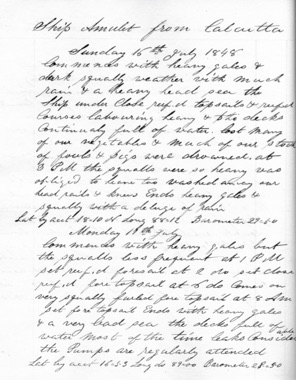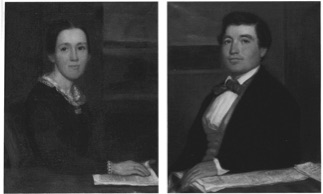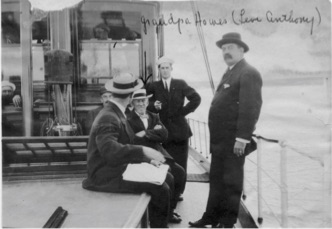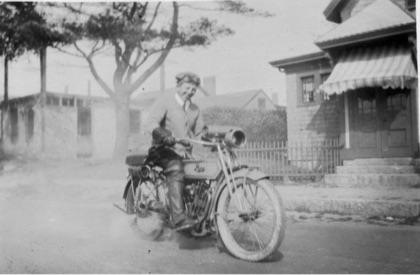by Nancy S. Bundy
“for we see people almost every day disappointed in their hopes & desires and we are taught to believe it is all for the best.”
August 22, 1848
The portraits of Captain Levi Howes (1812-1874) and his wife Myra, recently acquired by the Dennis Historical Society and published in their September, 2010, newsletter, gave us the impetus to take a further look at the clipper ship logs of his brother, Captain Anthony Howes (1820-1868), in the Woods Hole Historical Collection. These log books of voyages by the Amulet and the Hippogriffe were donated by Ellen Clark Howes, wife of James Sturgis Howes, Jr.
In terse words describing a monsoon off Calcutta flooding the decks and drowning fowl, pigs and vegetables that were provisions for the voyage home; worries of looming water-rationing while becalmed in the Bay of Bengal; moments of lonely reflection on a life at sea and friends left behind; the need to shake off poetry reading and return to practical matters; forfeiting tobacco-chewing in favor of an occasional cigar for health reasons, the log book of the Amulet provides a glimpse, in an elegant cursive hand, of both the inner and worldly life of a clipper ship captain.
 From the tiny squiggle that is Sesuit Harbor on the map of Cape Cod Bay, came some of the finest sailing ships in the history of maritime commerce. The Shiverick Shipyard built clipper ships sailed by the seagoing sons of East Dennis, prominent among them the Howes and the Crowells. Their stories the Shivericks, the Howes and the Crowells are deeply entwined with the history of Woods Hole in the 1800s.
From the tiny squiggle that is Sesuit Harbor on the map of Cape Cod Bay, came some of the finest sailing ships in the history of maritime commerce. The Shiverick Shipyard built clipper ships sailed by the seagoing sons of East Dennis, prominent among them the Howes and the Crowells. Their stories the Shivericks, the Howes and the Crowells are deeply entwined with the history of Woods Hole in the 1800s.
In 1639, Thomas Howes and John Crowell and their wives helped found a community on the only harbor that is fully navigable at high and low tides between the shoaled harbors of Barnstable and Wellfleet. One of the best harbors on the east coast in nearby Provincetown must have appeared too desolate a set of sand dunes in which to raise families and to farm to feed them. Two hundred years later, the clipper ships of 1,000 tons built by the Shiverick sons required launching at the zenith of tides in the spring or the fall with a brief window of opportunity each day.
In the 1690s, the Reverend Samuel Shiverick settled in Puritan Falmouth and served as minister from 1701 to 1702 when he was relieved of his duties for his liberal thinking and independence.
Four generations later his descendent, Asa Shiverick (1790–1861), traveled to East Dennis to build schooners and packets and marry Susanna Howes. Their sons, Asa (1816-1894), David and Paul, expanded their skills in Boston, engaged the designer Samuel H. Pook, selected the best woods from Maine and built eight clipper ships between 1850 and 1862, including the Hippogriffe.
Asa Shiverick, the son, came to Woods Hole in 1863 to manage the Pacific Guano Company. He is buried with his son, Asa Frank Shiverick, their wives and descendents, behind The Church of the Messiah in Woods Hole.
Captain Anthony Howes’ logs reveal the role of international businessman required of the clipper ship captain. In port for a month in Calcutta negotiating for cargo, stopping in ports for newspapers, exchanging news at sea with foreign sea captains noting “the Dutch at war and France in trouble;” the business savvy necessary to be successful in that fiercely competitive world compelled the Shivericks and Crowells and Howes to invest in other enterprises too. The difficulty of finding profitable cargo, the crash of 1857, the Civil War, the advent of steamships, the opening of the Suez canal, and the regulation of the China Trade, all spelled the end of the clipper ship era. Captain Prince S. Crowell, searching for a port for a guano factory to manufacture fertilizer vital to feed the country and cotton industry and fill his ships’ holds, was diverted from Holmes Holl (Vineyard Haven) to Woods Holl by bad weather. Falmouth did not have an inner harbor then and Woods Hole provided a southerly, accessible, protected haven for shipping. Captain Crowell chose the tail of land now called Penzance Point and established the Pacific Guano Company there in 1859, creating another source of revenue and employment for the extended families of Dennis.
Captain Levi Howes, whose portrait is in Dennis, had a son, Levi Anthony Howes (1845 -1930). In the tradition of sea captain’s sons, Levi Anthony was initiated into a career at sea around age 12 with his uncle Anthony Howes, captain of the clipper ship Hippogriffe. On his very next trip, Levi Anthony was shipwrecked in the China seas and promptly quit seafaring. For five years he served in South Dennis as station agent for The Old Colony Railroad. The railroad was yet another venture of Captain Crowell’s. In 1880, Levi Anthony was appointed agent for the railway in Woods Hole and this date likely marks his move to Woods Hole with his wife, Elizabeth Taylor Howes, daughter of James Sturgis Howes I. Their children are double Howes of the extended families; not unusual at the time. Levi Anthony Howes (8th generation from Thomas Howes) is also buried behind the Church of the Messiah with his wife and children, including son James Sturgis Howes II whose son, James Sturgis Howes, Jr. (10th generation from Thomas Howes) married Ellen Clark Howes. Ellen C. Howes spent summers on Oyster Pond Road.
The voyage of the Amulet begins November 1847 in New Haven, when Captain Anthony Howes was 27 years old, then rounds the Cape of Good Hope to Calcutta, and returns to Boston, December 1848. Captain Anthony laments that the short spars considerably slowed progress. In the back of the log he lists size ratio formulas for sails and spar lengths. He includes recipes for fireworks: brimstone, salt petre, and charcoal; paint mixtures; and verses for a gold rush song “California Emigrants” to the tune of “Oh Susanna.” The Captain makes no bones about his frustration with his ambitionless, worthless first mate who whistles and hums all day long while failing to take charge. The chores of caulking decks, lowering boats to scrape barnacles off the hull, paint the masts and repair sails while at sea are all duly recorded. He protests the hardened, trouble-making crew’s refusal to eat pumpkins they claim were only fit for pigs. He never identifies the cargo, typically the highly profitable light freight of people, tea, rice, spices, mail, silk and medicinal opium.
Pages left enticingly blank at the completion of Amulet’s voyages, thriftily contain entries made later for sail ratios for the Hippogriffe. He made reference to the famous incident when the Hippogriffe ran aground in the Straits of Jasper and sailed into port with a piece of coral jammed in her hull. He cites an item from the Mercantile and Marine Magazine of London, July 1859, describing a sunken bark with masts standing exposed at the exact same location now known as Hippogriffe Shoal. He notes on March 11, 1862, the “telegraph at Belle Isle France connecting with all of Europe,” and we further grasp the impact of international news on these astute seafaring businessmen.
On January 5, 1853, an article published in The New York Times sadly opens with “Loss of Ship Amulet, of Boston, AND Fifteen Lives.” The Captain of the ship Annawan arrived in Boston having rescued Captain Paul Howes, first mate Thomas Howes, and two other crew bound for Boston with salt. Captain Howes reported that Amulet sprang a leak in a severe northwest gale and the “pumps could not free her.” He ordered the men over the sides into the lifeboats and believed the other two lifeboats were “stove in getting them over.” The ship went down with fifteen men, including two stowaways from Cette, in a heavy sea. A grim reminder that investments of shares in the ships and their cargo financed by the ship captains, the merchant companies in Boston and New York, and townspeople of Dennis, were a high return high risk venture in profits and in lives.
The second log book by Captain Anthony Howes in the Woods Hole Historical Collection records the maiden voyage of the Hippogriffe, but that is another story waiting to be told, to remind us through history of where we come from, who we are, where we are heading.
October, 2010

Portraits of Captain Levi Howes and his wife Myra. Note the resemblance of Levi Anthony Howes in the photo below, second from left, to his mother Myra, left. Portraits Courtesy of Dennis Historical Society.

Levi Anthony Howes, second from the left, on board the U.S. Fish Commission vessel Phalarope in Woods Hole, about 1903. Howes Sea Captains Collection, WHHC
 James Sturgis Howes on a motorcycle in front of the family home on Main (Water) Street, early 1900s. The house was across the road from the U.S. Fish Commission Residence and is the site of the present Whitman-Rowe Lab of the MBL on Water Street. Of interest is the demolition of the house behind him, being torn down to build the MBL Mess. The house being demolished was a large 18th century house owned by Braddock Gifford, blacksmith to the Quissett Harbor shipyard in the early 1800s, and who was later blacksmith for the Woods Hole Bar Neck Wharf whaling ships owned by the Swifts in the mid-1800s.
James Sturgis Howes on a motorcycle in front of the family home on Main (Water) Street, early 1900s. The house was across the road from the U.S. Fish Commission Residence and is the site of the present Whitman-Rowe Lab of the MBL on Water Street. Of interest is the demolition of the house behind him, being torn down to build the MBL Mess. The house being demolished was a large 18th century house owned by Braddock Gifford, blacksmith to the Quissett Harbor shipyard in the early 1800s, and who was later blacksmith for the Woods Hole Bar Neck Wharf whaling ships owned by the Swifts in the mid-1800s.
Howes Sea Captains Collection, WHHC.
Crowells and Shivericks in Woods Hole
Azariah Crowell, the son of Captain Prince Sears Crowell, came to Woods Hole to work as the chemist in the Pacific Guano Company. In 1871 he built a beautiful white Italianate Revival house across from the present Woods Hole Post Office. His father complained about the expense of his original fancier plan. Go look at the results. It is used by WHOI for offices.
When Asa Shiverick, Jr. came to Woods Hole in 1869 to manage the Guano Company, he bought an 1843 house at the corner of School and Water Street and added porches and some Victorian brackets to it. The house was moved across School Street in 1949. It is owned by WHOI and used for offices
